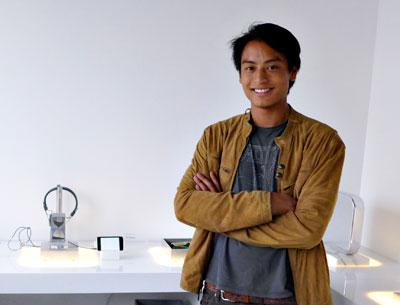Not Your Typical Pop-Up

Like them or hate them, pop-ups have become commonplace on the South Fork. From Whole Foods to Shuko, from Dash to Joe Fresh, shops, restaurants, and even art galleries have been sprouting up every summer since Nobu opened at the Capri motel in Southampton in 2011.
“The App Store” in Sag Harbor will close at the end of business on Sunday after a two-month run at GeekHampton on Bay Street, but it can’t be accused of trying to make a quick buck.
“The whole thing is really a sculpture,” said Evan Desmond Yee, a 24-year-old artist selected for one of this year’s Parrish Road Show projects. The program was initiated in 2012 by Andrea Grover, the museum’s curator of special projects, to invite artists to create off-site installations that would bring art into the community and engage a wider audience.
“The App Store” was constructed by Mr. Yee and his team as a separate space within GeekHampton. The shop’s products are physical realizations of digital phenomena. “The digital to the physical is a big part of my thing,” said Mr. Yee, “because I think we’re really bridging that gap with all our technology that can sort of consume the world and digitize it.”
Oddly enough, the artist, who lives in Brooklyn but whose father and stepmother are the proprietors of Sag Harbor’s Yoga Shanti, says he doesn’t know a lot about tech. “I wanted to create all this in a way that’s accessible to the average tech consumer, which I am.”
Mr. Yee calls the “iWait Sticker/Magnet” the “wheel of death.” The object is a magnetized vinyl sticker that represents the colorful circular icon that spins on a computer screen while information is loading. “The idea,” he said, “is that you take these things and stick them in spaces where people are waiting.”
When you click on a menu item on Mr. Yee’s website, the icon starts spinning as if the computer is freezing up. “People just sit there and finally walk away,” not realizing the icon has been planted by Mr. Yee to fool them.
Another piece is “timeline,” a book in the graphic style of Facebook whose logo, the letter “t,” is an inversion of the Facebook “f.” The book’s 79 pages correspond to the years of the average American life span. Each page lists the things an average person consumes that year, for example oxygen inhaled, money earned and spent, carbon dioxide exhaled, as well as what has been consumed cumulatively since birth. “It’s based on bad Google statistics,” said the artist.
Mr. Yee grew up in Oakland, Calif., where his mother still lives. He started doing origami as a boy, seriously enough to attend conventions. He began to draw and paint in high school and, “thanks to a really good art teacher,” decided to go to art school. He graduated from Pratt Institute in 2013.
“iFlip” is a piece that has been getting a great deal of attention, according to Mr. Yee. The object is an hourglass housed within the frame of an iPhone. Instead of sand, it’s filled with eight grams of ground-up iPhone. “I wanted to treat it as sort of an urn for an iPhone.”
“Kaleidogram 5S” is a brass device that transforms an iPhone camera into a kaleidoscope. Another piece, “Nocuous Rift,” is based on the virtual reality headset the Oculus Rift. It is essentially a stereoscope, which combines two flat images into a three-dimensional one. When two iPhones are attached and set on camera, the world is seen through the device in three dimensions. “I call them reality goggles, because through them you only see what you would see in real life, but on your iPhone screen instead.”
The “App App” is a sculptural replica of the ubiquitous app icon. The three-dimensional square with rounded corners is made from solid aluminum, milled down, sanded on the sides, routed, and painted. Mr. Yee cut the pieces with a chop saw.
In fact, the artist had to learn everything from InDesign for the timeline book to glass-cutting for the kaleidoscope attachments. For the latter, he had no choice. “Glass-cutters said it would cost me too much money for them to grind such a small amount of glass.” He constructed “Nocuous Rift” from cardboard and duct tape, then cast the object in aluminum, retaining the crude texture of the underlying materials.
Many people have discovered “The App Store” while at GeekHampton, others while walking past. “When people walk by and look in, they wonder what this is. People who know art come in, but so do people who don’t see it as an art piece. I was hoping the two audiences would relate to each other and that the language of the show would reach both.”
The objects in “The App Store” are not only sophisticated transformations of digital phenomena into objects, but also conceptually elegant and consistently droll.
